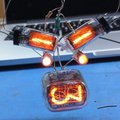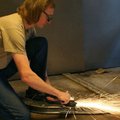 If you need a GPS unit capable of operating at these altitutdes, or an ion thruster for a private project how can you be a member of the general public and attempt this? DIY sort of implies anyone with the knowhow could attempt this but there are obvious barriers, aren't there? Do you have to be professionally certified to be launching these satellites and get your hands on requisite hardware? You mention 'spicy solar panels' and radiation hardened hardware, stuff that isn't easily available to even a hobbyist engineer off hand. I feel like a lot of the DIY part of what you're saying is incomplete, of course you can use a Raspberry Pi or SDR or anything you like, but what about the stuff that you absolutely need? What's the process like?
If you need a GPS unit capable of operating at these altitutdes, or an ion thruster for a private project how can you be a member of the general public and attempt this? DIY sort of implies anyone with the knowhow could attempt this but there are obvious barriers, aren't there? Do you have to be professionally certified to be launching these satellites and get your hands on requisite hardware? You mention 'spicy solar panels' and radiation hardened hardware, stuff that isn't easily available to even a hobbyist engineer off hand. I feel like a lot of the DIY part of what you're saying is incomplete, of course you can use a Raspberry Pi or SDR or anything you like, but what about the stuff that you absolutely need? What's the process like?

 @Boian Mitov - like tin whiskers?
@Boian Mitov - like tin whiskers?
 Hey guys, I'm running very short on time here, gonna try to answer a few quick
Hey guys, I'm running very short on time here, gonna try to answer a few quick
![]() Can you just sneak tin-lead in? Would mitigate both the whiskers and tin pest.
Can you just sneak tin-lead in? Would mitigate both the whiskers and tin pest.
 I feel like I heard a lot of stuff about open source space tech before from outfits like Copenhagen Suborbitals for example, but eventually they had to take their designs down because of security concerns
I feel like I heard a lot of stuff about open source space tech before from outfits like Copenhagen Suborbitals for example, but eventually they had to take their designs down because of security concerns
 No worries, we're up against the top of the hour anyway.
No worries, we're up against the top of the hour anyway.


![]() Thought. GaN-based optocouplers. Ordinary optos are GaAs that is rather rad-sensitive. GaN should be way more robust. Blue LED optically coupled over a photosensor?
Thought. GaN-based optocouplers. Ordinary optos are GaAs that is rather rad-sensitive. GaN should be way more robust. Blue LED optically coupled over a photosensor?
![]() Indium solders for cryo... nom!
Indium solders for cryo... nom!
 Wait, is there enough atmosphere for buoyancy to work on the low orbit sattelite?
Wait, is there enough atmosphere for buoyancy to work on the low orbit sattelite?
 - Tin whiskers are a concern, but we mitigate this whenever possible using very little solder, and specialized ( fairly certain it can be got on Amazon )
- Tin whiskers are a concern, but we mitigate this whenever possible using very little solder, and specialized ( fairly certain it can be got on Amazon )
GPS chips themselves are required to not work higher than certain altitudes or faster than certain speeds. However, it's not actually needed to know the positioning. Orbits are fairly reliable and after a location is locked, we can track it until re-entry using math and signal reaquisition alone.
 > I feel like I heard a lot of stuff about open source space tech before from outfits like Copenhagen Suborbitals for example, but eventually they had to take their designs down because of security concerns
> I feel like I heard a lot of stuff about open source space tech before from outfits like Copenhagen Suborbitals for example, but eventually they had to take their designs down because of security concerns
@lakeskin This is part of why we are maintaining a versioning gap in our releases.
 How long do they orbit for? I'm guessing a few months?
How long do they orbit for? I'm guessing a few months?
 what if you have to make adjustments? are reaction wheels enough to change your trajectory?
what if you have to make adjustments? are reaction wheels enough to change your trajectory?
 Our estimated mission duration per-sat is 3-5 years @anfractuosity.
Our estimated mission duration per-sat is 3-5 years @anfractuosity.
 sorry i mean in terms of staying in orbit
sorry i mean in terms of staying in orbit
 oh wow!
oh wow!
 @lakeskin Reaction wheels are more like flailing your arms while sitting on a barstool. You sort of just spin.
@lakeskin Reaction wheels are more like flailing your arms while sitting on a barstool. You sort of just spin.
That's why we have Thrust!
![]() What fuel for the ion engines?
What fuel for the ion engines?
![]() Could laser-ablation of an otherwise inert block of solid "fuel" work too?
Could laser-ablation of an otherwise inert block of solid "fuel" work too?
 Check out the link above for AIS, there's a few different fuels.
Check out the link above for AIS, there's a few different fuels.
Alright, last call for images, questions, anything else before I have to go!
 I assumed ion engines were for special missions, are they on all your satellites?
I assumed ion engines were for special missions, are they on all your satellites?
![]() What material for wire insulations to cope with space?
What material for wire insulations to cope with space?
![]() Any conformal coatings on the boards?
Any conformal coatings on the boards?
 And can you buy an ion thruster as a hobbyist lol
And can you buy an ion thruster as a hobbyist lol
 that'd be a fun thing to play with, i assume you need a vac chamber to measure the thrust on earth?
that'd be a fun thing to play with, i assume you need a vac chamber to measure the thrust on earth?
![]() I saw somewhere a vacuum glovebox using arms from a spacesuit...
I saw somewhere a vacuum glovebox using arms from a spacesuit...
 > I assumed ion engines were for special missions, are they on all your satellites?
> I assumed ion engines were for special missions, are they on all your satellites?
All of our main constellation sats, we're aiming for 400 in orbit at the same time!
> And can you buy an ion thruster as a hobbyist lol
Joe found AIS through friends, but aside from being back-ordered, I believe the answer is totally yes!
![]() You can make ion Thruster for air pretty easily.
You can make ion Thruster for air pretty easily.
 Ours are indeed vac-only
Ours are indeed vac-only
 yes of course for vacuum, not for air.
yes of course for vacuum, not for air.
 Alright everyone, Thank you SO MUCH!
Alright everyone, Thank you SO MUCH!
I had a blast, if you need to reach out to me I'm frantically available via email at nathaniel.evry@quub.space and twitter @NathanielEvry
That' is of course if you can get me out of a cleanroom ;P
 @Nathaniel@quub.space Thanks for an inspirational hack chat!
@Nathaniel@quub.space Thanks for an inspirational hack chat!
 @Nathaniel@quub.space, thanks so much for dropping by today, this was fantastic. Lots of great discussion, plenty to learn. And great questions from everyone, too. Thanks to all!
@Nathaniel@quub.space, thanks so much for dropping by today, this was fantastic. Lots of great discussion, plenty to learn. And great questions from everyone, too. Thanks to all!
And transcript coming right up, too. Thanks all!

![]() Very inspirational. Thanks!
Very inspirational. Thanks!
![]() Don't they use like Xenon as "fuel" normally, because of being non-reactive??
Don't they use like Xenon as "fuel" normally, because of being non-reactive??
 thx a lot, very inspiring!
thx a lot, very inspiring!
 thanks a lot!
thanks a lot!

 Thanks @Dan Maloney !
Thanks @Dan Maloney !
 And make sure you come by next week:
And make sure you come by next week:


https://hackaday.io/event/190943-desktop-edm-hack-chat
Desktop EDM Hack Chat
Precision parts, one spark at a time
 Thank you all!
Thank you all!
 Dan Maloney
Dan Maloney
Discussions
Become a Hackaday.io Member
Create an account to leave a comment. Already have an account? Log In.